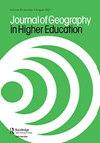足球之旅:移民、公民身份和国家认同
IF 1
4区 教育学
Q2 EDUCATION & EDUCATIONAL RESEARCH
引用次数: 1
摘要
体育,特别是足球,可以为探索移民和民族认同的相关问题提供有用的手段。体育明星从一个国家迁移到另一个国家,往往反映了从外围到核心的更广泛的迁移模式。这种运动受到一系列因素的影响。在日益商业化和全球化的体育运动中,对足球运动员的根源和他们所走路线的探索,引发了对地方身份和归属感问题的考虑。在国际体育比赛中,运动员穿上国家的国旗,唱国歌,“升国旗”,通过这样做,他们成为更广泛的想象共同体的化身。传统上,那些争夺国家的人通常在那里出生和长大,或者在那里生活了相当长的一段时间。然而,近年来,国际运动队选择在其他国家出生的运动员已经变得越来越普遍。这些足球例子的使用提供了对移民、散居、公民身份、全球化以及国家认同的多层次和偶然性的见解。体育可以提供一种有用的手段来阐明这些不同的地理主题和社会空间过程,从而使学生更容易理解和感兴趣。本文章由计算机程序翻译,如有差异,请以英文原文为准。
Footballing journeys: migration, citizenship and national identity
Sport, in particular football, can provide a useful means through which to explore the related issues of migration and national identity. Sports stars migrate from one country to another often mirroring patterns of more widespread migration from periphery to core. Such movements are influenced by a range of factors. In an increasingly commercialised and globalised sport, the exploration of footballers’ roots and the routes they take feeds into a consideration of issues of place identity and belonging. In international sporting competition, competitors don the national colours, sing the anthem and “fly the flag”, and in doing so become the embodiment of the wider imagined community. Traditionally those who compete for countries have usually been born and raised there or have lived there for sizeable periods of their lives. In recent years, however, the selection by international sports teams of competitors born in other countries has become increasingly common. The use of these footballing examples provides insights into migration, diaspora, citizenship, globalisation, and the multi-layered and contingent nature of national identity. Sport can offer a useful means of illuminating these various geographic themes and socio-spatial processes, thereby rendering them more accessible and interesting to students.
求助全文
通过发布文献求助,成功后即可免费获取论文全文。
去求助
来源期刊

Journal of Geography in Higher Education
Multiple-
CiteScore
5.80
自引率
9.50%
发文量
29
期刊介绍:
The Journal of Geography in Higher Education ( JGHE) was founded upon the conviction that the development of learning and teaching was vitally important to higher education. It is committed to promote, enhance and share geography learning and teaching in all institutions of higher education throughout the world, and provides a forum for geographers and others, regardless of their specialisms, to discuss common educational interests, to present the results of educational research, and to advocate new ideas.
 求助内容:
求助内容: 应助结果提醒方式:
应助结果提醒方式:


